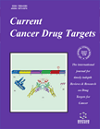- Home
- A-Z Publications
- Current Cancer Drug Targets
- Previous Issues
- Volume 8, Issue 7, 2008
Current Cancer Drug Targets - Volume 8, Issue 7, 2008
Volume 8, Issue 7, 2008
-
-
The Protein Acetyltransferase ARD1: A Novel Cancer Drug Target?
More LessAuthors: Thomas Arnesen, Paul R. Thompson, Jan E. Varhaug and Johan R. LillehaugEvasion of apoptosis and active cell proliferation are among the characteristics of cancer cells. Triggering the induction of apoptosis or reducing the proliferative rate will potentially be helpful for cancer treatment. Recently, several reports demonstrated that knockdown of the protein acetyltransferase hARD1 significantly reduced the growth rate of human cancer cell lines. Furthermore, hARD1 knockdown induced apo Read More
-
-
-
Cell-Specific Induction of Apoptosis by Rationally Designed Bivalent Aptamer-siRNA Transcripts Silencing Eukaryotic Elongation Factor 2
More LessAuthors: Ulrich Wullner, Inga Neef, Andreas Eller, Michael Kleines, Mehmet K. Tur and Stefan BarthNew strategies for cell type-specific delivery need to be developed if RNA interference is to realize its full therapeutic potential. One possible approach is the use of aptamers to deliver siRNAs selectively to tumor cells with appropriate antigens displayed on the surface. We used an aptamer that binds specifically to PSMA, a cell surface glycoprotein found in abundance on prostate cancer cells, and joined its 3' end to Read More
-
-
-
Notch Signaling: A Potential Therapeutic Target in Prostate Cancer
More LessAuthors: M. A. Villaronga, C. L. Bevan and B. BelandiaThe Notch pathway and the endocrine system constitute two key biological signaling mechanisms, responsible for cell-to-cell communication between adjacent cells and long-distance hormonal signals respectively. They play central roles during the development of higher eukaryotic organisms but they also take part in the regulation of many aspects of adult physiology and homeostasis. The contribution of defects in t Read More
-
-
-
Novel Virally Targeted Therapies of EBV-Associated Tumors
More LessEBV is associated to the development of several malignancies of lymphoid and epithelial origin, including Burkitt's Lymphoma, post-transplant lymphoproliferative disorders, Hodgkin's disease, AIDS-associated lymphomas, NK/T cell lymphoma and Nasopharyngeal carcinoma. EBV genes play an essential role in the development of the malignant phenotype and therefore molecules interfering with the function of these gen Read More
-
-
-
Interaction Between Estrogen Receptor Alpha and Insulin/IGF Signaling in Breast Cancer
More LessEstrogens and insulin/Insulin like growth factor 1 (IGF-I) have potent positive effects on the proliferation of mammary epithelial cells and estrogen-dependent breast cancer cells. A cooperative crosstalk between estrogens and insulin/ IGF-I signaling pathways exists and it plays a critical role in breast carcinogenesis, tumor cell proliferation, differentiation and survival through the modulation of multiple biological events. The biol Read More
-
-
-
Obesity-Enhanced Colon Cancer: Functional Food Compounds and their Mechanisms of Action
More LessAuthors: Jairam Vanamala, Christopher C. Tarver and Peter S. MuranoObesity is rapidly becoming a global phenomenon. This is more than a cosmetic issue as obesity is associated with several life-threatening diseases, including colon cancer. Insulin resistance and inflammation, underlying factors in obesity-related diseases, promote colonocyte proliferation and suppress programmed cell death, or apoptosis, by activating the insulin-like growth factor (IGF) and prostaglandin pathways. These path Read More
-
-
-
Luteolin, a Flavonoid with Potential for Cancer Prevention and Therapy
More LessAuthors: Yong Lin, Ranxin Shi, Xia Wang and Han-Ming ShenLuteolin, 3',4',5,7-tetrahydroxyflavone, is a common flavonoid that exists in many types of plants including fruits, vegetables, and medicinal herbs. Plants rich in luteolin have been used in Chinese traditional medicine for treating various diseases such as hypertension, inflammatory disorders, and cancer. Having multiple biological effects such as anti-inflammation, anti-allergy and anticancer, luteolin functions as either an antio Read More
-
Volumes & issues
-
Volume 25 (2025)
-
Volume 24 (2024)
-
Volume 23 (2023)
-
Volume 22 (2022)
-
Volume 21 (2021)
-
Volume 20 (2020)
-
Volume 19 (2019)
-
Volume 18 (2018)
-
Volume 17 (2017)
-
Volume 16 (2016)
-
Volume 15 (2015)
-
Volume 14 (2014)
-
Volume 13 (2013)
-
Volume 12 (2012)
-
Volume 11 (2011)
-
Volume 10 (2010)
-
Volume 9 (2009)
-
Volume 8 (2008)
-
Volume 7 (2007)
-
Volume 6 (2006)
-
Volume 5 (2005)
-
Volume 4 (2004)
-
Volume 3 (2003)
-
Volume 2 (2002)
-
Volume 1 (2001)
Most Read This Month
Article
content/journals/ccdt
Journal
10
5
false
en


